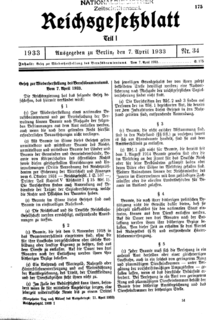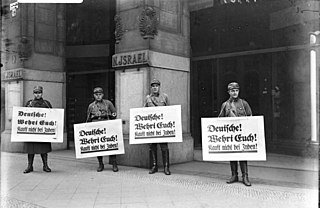
The Wannsee Conference was a meeting of senior government officials of Nazi Germany and Schutzstaffel (SS) leaders, held in the Berlin suburb of Wannsee on 20 January 1942. The purpose of the conference, called by the director of the Reich Main Security Office SS-Obergruppenführer Reinhard Heydrich, was to ensure the cooperation of administrative leaders of various government departments in the implementation of the Final solution to the Jewish question, whereby most of the Jews of German-occupied Europe would be deported to occupied Poland and murdered. Conference attendees included representatives from several government ministries, including state secretaries from the Foreign Office, the justice, interior, and state ministries, and representatives from the SS. In the course of the meeting, Heydrich outlined how European Jews would be rounded up and sent to extermination camps in the General Government, where they would be killed.

Kristallnacht or Reichskristallnacht, also referred to as the Night of Broken Glass, Reichspogromnacht[ˌʁaɪçs.poˈɡʁoːmnaχt] or simply Pogromnacht[poˈɡʁoːmnaχt](listen), and Novemberpogrome[noˈvɛmbɐpoɡʁoːmə](listen), was a pogrom against Jews throughout Nazi Germany on 9–10 November 1938, carried out by SA paramilitary forces and civilians. The German authorities looked on without intervening. The name Kristallnacht comes from the shards of broken glass that littered the streets after the windows of Jewish-owned stores, buildings, and synagogues were smashed.

The racial policy of Nazi Germany was a set of policies and laws implemented in Nazi Germany (1933–45) based on a specific racist doctrine asserting the superiority of the Aryan race, which claimed scientific legitimacy. This was combined with a eugenics programme that aimed for racial hygiene by compulsory sterilization and extermination of those who they saw as Untermenschen ("sub-humans"), which culminated in the Holocaust.

The Romani genocide or the Romani Holocaust—also known as the Porajmos, the Pharrajimos, and the Samudaripen —was the effort by Nazi Germany and its World War II allies to commit genocide against Europe's Romani people.
Mischling was the legal term used in Nazi Germany to denote persons deemed to have both "Aryan" and Jewish ancestry. The Germanic root is cousin to the Latin term whence the Spanish term mestizo and French term métis originate.
A German Blood Certificate was a document provided by Hitler to Mischlinge, declaring them deutschblütig. This practice was begun sometime after the Nuremberg Laws of 1935, and allowed exemption from most of Germany's racial laws.

Functionalism versus intentionalism is a historiographical debate about the origins of the Holocaust as well as most aspects of the Third Reich, such as foreign policy. The debate on the origins of the Holocaust centres on essentially two questions:

The Law for the Restoration of the Professional Civil Service, also known as Civil Service Law, Civil Service Restoration Act, and Law to Re-establish the Civil Service, was a law passed by the National Socialist regime of Germany on 7 April 1933, two months after Adolf Hitler had attained power.
Geltungsjude was the term for people who were considered Jews by the first supplementary decree to the Nuremberg Laws from 14 November 1935. The term wasn't used officially, but was coined because the persons were deemed Jews rather than exactly belonging to any of the categories of the previous Nuremberg Laws. There were three categories of Geltungsjuden: 1. offspring of an intermarriage who belonged to the Jewish community after 1935; 2. offspring of an intermarriage who was married to a Jew after 1935; 3. illegitimate child of a Geltungsjude, born after 1935.

The Ahnenpaß documented the Aryan lineage of citizens of Nazi Germany. It was one of the forms of the Aryan certificate (Ariernachweis) and issued by the "Reich Association of Marriage Registrars in Germany".

The Nazi boycott of Jewish businesses in Germany began on April 1, 1933, and was claimed to be a defensive reaction to the Jewish boycott of German goods, which had been initiated but quickly abandoned in March 1933. It was largely unsuccessful, as the German population continued to use Jewish businesses, but revealed the intent of the Nazis to undermine the viability of Jews in Germany.
Mischling Test refers to the legal test under Nazi Germany's Nuremberg Laws that was applied to determine whether a person was considered a "Jew" or a "Mischling" (mixed-blood).
The Reich Association of Jews in Germany also called the new one for clear differentiation, was a Jewish umbrella organisation formed in Nazi Germany in February 1939. The Association branched out from the Reich Representation of German Jews established in September 1933. The new Association was an administrative body concerned predominantly with the coordination and support of the emigration and forcible deportation of Jewish people, subject to the Reich government's ever-changing legislation enforced by the RSHA (Reichssicherheitshauptamt). The legal status of the new organisation was changed on 4 July 1939 on the basis of the Nuremberg Laws, and defined by the 10th Regulation to the Citizenship Law issued by the Reich's ministry of the Interior. The Association assumed the so-called oldReichsvereinigung der Juden in Deutschland, which was the name under which the Reichsvertretung der Deutschen Juden had been operating since February 1939.
Anti-Jewish laws have been a common occurrence throughout Jewish history. Examples of such laws include special Jewish quotas, Jewish taxes and Jewish "disabilities".
Bernhard Lösener, was a lawyer and Jewish expert in the Reich Ministry of the Interior. Along with Wilhelm Stuckart, he helped draft the Nuremberg Laws, among other legislation that deprived German Jews of their rights and ultimately led to their deportation to concentration camps.

The German Citizenship Project encourages descendants of Germans deprived of their citizenship by Nazi Germany to reclaim that citizenship without losing the citizenship of their home country.
The Polenaktion, or "Polish Action," refers to the arrests and expulsion of approximately 17,000 Polish Jews living within the German Reich in October 1938. These deportations, ordered by SS officer and head of the Gestapo Reinhard Heydrich, displaced thousands of Polish Jews along the Germany-Poland border.
Leipzig is the largest city in the German state of Saxony, and one of the largest cities in Germany. It is located in the northern half of Germany, south of Berlin. The history of Leipzig from 1933 to 1939, is affected by the actions of the Nazi regime. From the beginning of the Nazi party's rise to power in 1933, to the beginning of World War II in 1939, Leipzig was an important city to the regime. Thousands of Jews were transported to and from this city as Adolf Hitler's plans for the Jewish people evolved. Between the years of 1933 to 1939, Jews suffered from the implementation of over 400 anti-Jewish policies, laws, and regulations. However, other than the history of the Holocaust, Leipzig, Germany has a rich history and culture.

The period from 1933 to 1945 saw Germany and most of Europe dominated by the Nazi regime. During this time, Nazi Germany shifted away from its post-World War I society, with the “biological racism" of Nazi ideology increasingly superimposed on the legal and justice system. This has been classified as movement away from Germany's ‘Normative State’, the traditional legal system; towards a ‘Prerogative State’, in which the mass atrocities typical of the Nazi regime were carried out. For this to succeed, the formal justice system was significantly dependent on judges, lawyers and other civil servants in order for them to acclimatise themselves to Nazi interference.














